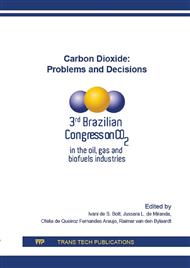[1]
J. L. Creek, J. Wang, J. S. Buckley, Verification of Asphaltene-Instability-Trend (ASIST) Predictions for Low-Molecular-Weight Alkanes, SPE 125203. (2009).
DOI: 10.2118/125203-pa
Google Scholar
[2]
IP -143/01 Method - Determination of asphaltenes (heptane insoluble) in crude petroleum and petroleum products, Institute of Petroleum, London, UK, (2001).
DOI: 10.1520/d6560-12
Google Scholar
[3]
M. R. Gray; R. R. Tykwinsky; J. M. Stryker; X. Tan, Supramolecular Assembly Model for Aggregation of Petroleum Asphaltenes. Energy & Fuels, v. 25, n. 7, pp.3125-3134, (2011).
DOI: 10.1021/ef200654p
Google Scholar
[4]
J. B. J. D. Boussingault (1802 -1887), Information on: pt/wikipedia. org, access: 08/09/2014, 10: 00h.
Google Scholar
[5]
Z. Wang, J. Ma, R. Ga, F. Zeng, C. Huang, P. Tontiwachwuthikul, Z. Liang, Optimizing cyclic CO2 injection for low- permeability oil reservoirs through experimental study, SPE 167193. (2013).
DOI: 10.2118/167193-ms
Google Scholar
[6]
V. Sharma, A. Groenzin, A. H. Tomiata, O. C. Mullins, Asphaltene molecular size and structure, Energy & Fuels (2002) 16, 490.
Google Scholar
[7]
C. A. Lalchan, B. J. Neil, D. M. Maley, Prevention of acid induced asphaltene precipitation: a comparison of anionic vs. cationic surfactants. SPE 164087, (2013), doi: 10. 2118/164087-MS.
DOI: 10.2118/164087-ms
Google Scholar
[8]
L. Nabzar, M. E. Aguillera, Y. Rajoub, Experimental study on asphaltene-induced formation damage, SPE 93062. (2005).
DOI: 10.2118/93062-ms
Google Scholar
[9]
S. Negahban, N. Joshi, A. K. M. Jamaluddin, J. Nighswander, A systematic approach for experimental study of asphaltene deposition for an Abu Dhabi reservoir under WAG development plan, SPE 80261. (2003).
DOI: 10.2118/80261-ms
Google Scholar
[10]
B. Lepski, Z. Bassiouni, J. M. Wolcott, Screening of oil reservoirs for gravity assisted gas injection, SPE 39659, (1998), doi: 10. 2118/39659-MS.
DOI: 10.2118/39659-ms
Google Scholar
[11]
K. D. Hakendorn, F. M Orr, Component partitioning in CO2/crude oil systems: effects of oil composition on CO2 displacement performance , SPE 25169. (1994).
DOI: 10.2118/25169-pa
Google Scholar
[12]
E. F. Gholoum, G. P Oskui, M. Salman, Investigation of asphaltene precipitation onset Conditions for Kuwaiti Reservoirs". SPE 81571. (2003).
DOI: 10.2118/81571-ms
Google Scholar
[13]
S. M. Al-Mutairi, S. A. Abu-Khamsin, M. E. Hossaim, A novel approach to handle continuous wettability alteration during immiscible CO2 flooding process, SPE 160638. (2012).
DOI: 10.2118/160638-ms
Google Scholar
[14]
H. Elshahaki, M. N. Hashen, O. C. Mullins, G. Fujisawa, The missing link - identification of reservoir compartmentalization through downhole fluid analysis, SPE 94709. (2005).
DOI: 10.2118/94709-ms
Google Scholar
[15]
J. Burke, Solubility parameters, theory and application, J. Amer. Inst. of Conservation, (Vol 3), (1984).
Google Scholar
[16]
C. R. Mansur, J. I. S. Aguiar, P. R. S. Silva, E. F. Lucas, G. González, Determining the solubility parameter of asphaltenes by microcalorimetry, in: 10 th Int. Conf. on Pet. Phase Behavior and Fouling, Rio de Janeiro (2009).
Google Scholar
[17]
A. F. M. Barton, Handbook of solubility parameters and other cohesion parameters, 2nd edition (1991). CRC Press, Boca Raton, Florida, USA.
Google Scholar
[18]
D. Denney, EOR potential in the Middle East: current and future trends, JPT, January, 70 -73, (2012).
Google Scholar
[19]
S. M Al-Mutairi, S. L. Kokal, EOR potential in the Middle East: current and future trends. SPE 143287. (2011).
DOI: 10.2118/143287-ms
Google Scholar
[20]
M. K. Silva, F. M. Orr, Effect of oil composition on minimum miscibility pressure - Part 1: Solubility of hydrocarbons in dense CO2, SPE 14149. (1997).
DOI: 10.2118/14149-pa
Google Scholar
[21]
A. Harouaka, B. Trentham, S. Melzer, Long overlooked residual oil zones are brought to the limelight. SPE 167209 (2013).
DOI: 10.2118/167209-ms
Google Scholar
[22]
S. Rassenfoss, Carbon dioxide may offer an unconventional EOR option, JPT, (2), (2014).
DOI: 10.2118/0214-0052-jpt
Google Scholar
[23]
D. Abdallah, Impact of asphaltenes deposition on completion design for CO2 pilot in on onshore Abu Dhabi fields", SPE 162190. (2012).
DOI: 10.2118/162190-ms
Google Scholar
[24]
W. Li, D. S. Schechter, Using polymer alternating gas to maximize CO2 flooding performance. SPE 169942 (2014).
DOI: 10.2118/spe-169942-ms
Google Scholar


